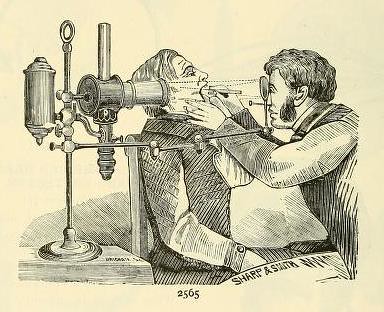Dr. R. Scott Stephens, Assistant Professor of Medicine and Director, Oncology and Bone Marrow Transplant Critical Care at Johns Hopkins University presents his work on Mechanical Ventilation Management during ECMO for ARDS.
Lecture Summary by Dr. Roxana Amirahmadi
Introduction
The objective of this lecture is to outline best mechanical ventilator practices after the decision has already been made to put a patient with ARDS on ECMO.
Background
VV-ECMO is used in the setting of ARDS to facilitate oxygenation and carbon-dioxide ventilation during a period when the lungs are less compliant than baseline and at higher risk of sustaining further injury.
VV-ECMO
A pump uses centrifugal force of generate 4-5 L/min of flow to pump blood outside the body over a membrane, across which there is a controlled and adjustable oxygen gradient (FDO2) that promotes oxygen diffusion into the blood. Dissolved CO2 escapes the serum across this membrane down its gradient, achieving successful ventilation. After the blood contacts this membrane, it returns to the body through a separate cannula.
- There are three adjustable parameters:
- Flow = A pump that uses centrifugal force of generate 4-5 L/min of flow that pumps blood outside the body and throughout the system
- Sweep = Ventilation; VE
- FDO2 = oxygen concentration across the membrane that the blood encounters, which establishes an oxygen gradient favoring oxygen diffusion into the blood.
- Oxygenation is determined by FDO2, flow rates, and venous mixing, recirculation, cardiac output. Higher flow rates lead to a higher percentage of oxygenated blood accounting for the cardiac output, which leads to higher oxygen saturations.
- Typical arterial O2 saturations are between 80-90%.
Caring for the lungs after initiating VV-ECMO
After deciding to put a patient on ECMO, we run the risk of forgetting about the lungs. There is no established guideline or standard of care of how to manage the lungs on the ventilator while a patient is on ECMO. The lungs have evolved to be mobile and some cyclic stretch may be good for vasculature epithelium as well. In vitro data has shown that low levels of cyclic stretch protect alveolar epithelial cells against oxidant induced cell death. 1 Even anoxic ventilation has been shown to be protective. 2 This suggest that some degree of tidal ventilation might be helpful in ECMO patients. During this talk, we will outline current ventilation practices in patients on ECMO and the best data available to guide clinical practices.
Current practices
The Lung Safe Study published in JAMA in 2016 showed that around the country, neuromuscular blockade, lung protective ventilation strategies, and proning are underused. 3 The LIFEGARDS study is an international multicenter prostpective cohort that followed patients on ECMO with ARDS in 23 ICUs from 10 countries for 1 year. 4 The following are the main points of this study:
- Demographics and daily ventilator settings were tracked in 350 patients on ECMO
- ICU and 6-month outcome data were reported
- Results revealed that prior to ECMO cannulation, patients were mostly on either Pressure-targeted or Volume-targeted settings, in approximately equal proportions. Lung protective settings were less likely to be utilized prior to ECMO than after placing the patient on ECMO
- “Ultra-protective” ventilation was common during ECMO with driving pressure < 15 cm H2O
- When patients were on ECMO, for the first 7 days, most patients were on pressure-targeted settings. In patients who had reached Day 28 on ECMO, almost 80% were on pressure-targeted settings.
- There was no association between specific vent settings and outcomes, but that might be because most patients were put on “ultra-protective†modes.
The Best Data Available Guiding Ventilator Strategies in ARDS Patients on ECMO
- The EOLIA Study: EOLIA showed that there was no difference in oxygenation or pH in patients on ECMO compared to patients not on ECMO. There was a difference in hypercarbia, respiratory rate, minute ventilation, and tidal volumes. Oxygenation was not associated with difference in survival, but low plateau pressures was beneficial. This suggests that the benefit of ECMO in ARDS is not necessarily correction of hypoxemia or hypercarbia, but rather allowing the patient to tolerate lung protective ventilation (lower respiratory rates, minute ventilations, tidal volumes, plateau pressures, and driving pressures).5
- Plateau pressures: Pplateau < 30 has also shown to be beneficial, but achieving low plateau pressures even prior to placing a patient on ECMO is associated with survival. 6
- Driving pressure: PD has an inverse relationship with mortality, with driving pressures < 14 being associated with improved survival7; this probably applies to ECMO patients as well. Having a lower driving pressure on Day 1 of ECMO is more likely to occur in survivors than non-survivors. 8, 9
- Alveolar recruitment: Maintaining alveolar recruitment likely also leads to improved survival; static inflation was shown to be protective and lead to decreased incidence of ischemic-reperfusion injury in rat lungs. 10
- PEEP: Higher PEEP is associated with improved ICU survivorship 9
- PaO2: Patients on ECMO can tolerate hypoxemia. A study in 2017 showed that patients did not exhibit significant cognitive impairment after being on ECMO for ARDS and experiencing prolonged hypoxemia. 11 Perhaps this suggests that we do not need to use patient’s lungs for oxygenation while on ECMO.
- PaCO2: There hasn’t been shown to be a difference in survivorship in patients with and without hypercarbia while on ECMO for ARDS.12, 13
- Role of spontaneous breathing: It’s important to keep in mind that on pressure control settings, you won’t know the effective delta-pressure in the lungs (difference between the pleural pressure and the driving pressure) if a patient is not paralyzed and sedated. A patient’s active breathing on top of the delivered pressure might lead to exceedingly elevated transpulmonary pressures. Maybe pressure modes are not as safe in the spontaneously breathing person. However, suppressing spontaneous breathing for prolonged periods can lead to diaphragm atrophy, which adversely affects patient outcomes and keeps patients on ventilator longer.
- Risk for Nitrogen Atelectasis: The risk for absorptive nitrogen atelectasis poses a distinct challenge when oxygenating patients on ECMO. If FdO2 >>> FiO2, FdN2 <<< FiN2. Due to the resulting large nitrogen gas gradient in the lungs (PAN2 >>> PaN2), nitrogen is absorbed into blood stream, leading to atelectasis. This can be prevented by setting FIO2 to be approximately equal to FdO2. It is unclear if this solution increases the risk of oxygen toxicity.
Summary
ECMO can be a useful tool to maximize lung protection in patients with ARDS. Current evidence favors the use of ultra-low tidal volumes with plateau pressures < 24, driving pressures < 14.Mode probably does not make a difference in outcomes, if low tidal volumes are achieved.Further work needs to be done to determine best practices.
References
- McAdams, R. M.; Mustafa, S. B.; Shenberger, J. S.; Dixon, P. S.; Henson, B. M.; DiGeronimo, R. J. Cyclic Stretch Attenuates Effects of Hyperoxia on Cell Proliferation and Viability in Human Alveolar Epithelial Cells. Am. J. Physiol.-Lung Cell. Mol. Physiol. 2006, 291 (2). https://doi.org/10.1152/ajplung.00160.2005.
- Schtte, H.; Hermle, G.; Seeger, W.; Grimminger, F. Vascular Distension and Continued Ventilation Are Protective in Lung Ischemia/Reperfusion. Am. J. Respir. Crit. Care Med. 1998, 157 (1). https://doi.org/10.1164/ajrccm.157.1.9706029.
- Bellani, G.; Laffey, J. G.; Pham, T.; Fan, E.; Brochard, L.; Esteban, A.; Gattinoni, L.; Haren, F. van; Larsson, A.; McAuley, D. F.; et al. Epidemiology, Patterns of Care, and Mortality for Patients With Acute Respiratory Distress Syndrome in Intensive Care Units in 50 Countries. JAMA 2016, 315 (8). https://doi.org/10.1001/jama.2016.0291.
- Schmidt, M.; Pham, T.; Arcadipane, A.; Agerstrand, C.; Ohshimo, S.; Pellegrino, V.; Vuylsteke, A.; Guervilly, C.; McGuinness, S.; Pierard, S.; et al. Mechanical Ventilation Management during ECMO for ARDS: An International Multicenter Prospective Cohort. Am. J. Respir. Crit. Care Med. 2019, rccm.201806-1094OC. https://doi.org/10.1164/rccm.201806-1094OC.
- Extracorporeal Membrane Oxygenation for Severe Acute Respiratory Distress Syndrome | NEJM https://www.nejm.org/doi/full/10.1056/NEJMoa1800385 (accessed Aug 17, 2019).
- Hager, D. N.; Krishnan, J. A.; Hayden, D. L.; Brower, R. G. Tidal Volume Reduction in Patients with Acute Lung Injury When Plateau Pressures Are Not High. Am. J. Respir. Crit. Care Med. 2005, 172 (10). https://doi.org/10.1164/rccm.200501-048CP.
- Amato, M. B. P.; Meade, M. O.; Slutsky, A. S.; Brochard, L.; Costa, E. L. V.; Schoenfeld, D. A.; Stewart, T. E.; Briel, M.; Talmor, D.; Mercat, A.; et al. Driving Pressure and Survival in the Acute Respiratory Distress Syndrome https://doi.org/10.1056/NEJMsa1410639.
- Pham, T.; Combes, A.; Roz, H.; Chevret, S.; Mercat, A.; Roch, A.; Mourvillier, B.; Ara-Somohano, C.; Bastien, O.; Zogheib, E.; et al. Extracorporeal Membrane Oxygenation for Pandemic Influenza A(H1N1) Induced Acute Respiratory Distress Syndrome: A Cohort Study and Propensity-Matched Analysis. Am. J. Respir. Crit. Care Med. 2013, 187 (3). https://doi.org/10.1164/rccm.201205-0815OC.
- Neto, A. S.; Simonis, F. D.; Barbas, C. S. V.; Biehl, M.; Determann, R. M.; Elmer, J.; Friedman, G.; Gajic, O.; Goldstein, J. N.; Linko, R.; et al. Lung-Protective Ventilation With Low Tidal Volumes and the Occurrence of Pulmonary Complications in Patients Without Acute Respiratory Distress Syndrome: A Systematic Review and Individual Patient Data Analysis*. Crit. Care Med. 2015, 43 (10), 2155. https://doi.org/10.1097/CCM.0000000000001189.
- Kao, S. J.; Wang, D.; Yeh, D. Y.-W.; Hsu, K.; Hsu, Y. H.; Chen, H. I. Static Inflation Attenuates Ischemia/Reperfusion Injury in an Isolated Rat Lung In Situ. Chest 2004, 126 (2), 552. https://doi.org/10.1378/chest.126.2.552.
- Holzgraefe, B.; Andersson, C.; Kalzen, H.; von Bahr, V.; Mosskin, M.; Larsson, E.-M.; Palmer, K.; Frenckner, B.; Larsson, A. Does Permissive Hypoxaemia during Extracorporeal Membrane Oxygenation Cause Long-Term Neurological Impairment?: A Study in Patients with H1N1-Induced Severe Respiratory Failure. J. Anaesthesiol. 2017, 34 (2). https://doi.org/10.1097/EJA.0000000000000544.
- Hickling, K. G.; Henderson, S. J.; Jackson, R. Low Mortality Associated with Low Volume Pressure Limited Ventilation with Permissive Hypercapnia in Severe Adult Respiratory Distress Syndrome. Intensive Care Med. 1990, 16 (6), 372.
- Hickling, K. G.; Walsh, J.; Henderson, S.; Jackson, R. Low Mortality Rate in Adult Respiratory Distress Syndrome Using Low-Volume, Pressure-Limited Ventilation with Permissive Hypercapnia: A Prospective Study. Crit. Care Med. 1994, 22 (10). https://doi.org/10.1097/00003246-199422100-00011.
Uploaded by Sami Safadi, MD
Podcast: Play in new window | Download
Subscribe: Apple Podcasts | RSS



